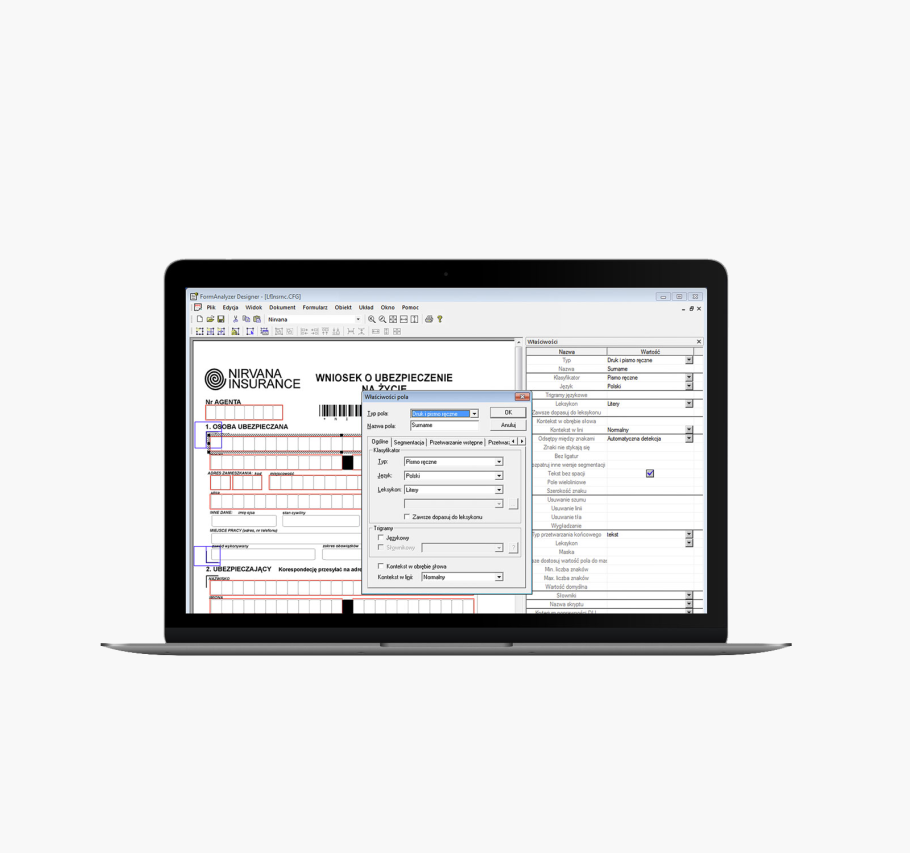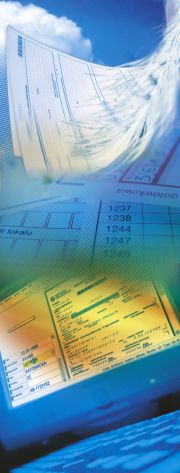FormAnalyzer
System for document digitization and data capture
FormAnalyzer is in line with international standards of production quality ensuring implementation of the requirements of regulators and providing highly reliable data.
FormAnalyzer provides modules implementing the processes of document scanning (digitization), images quality control, automatic document content extraction (OCR / ICR / Barcode / QRcode), automatic document classification, verification of meta-data and integration with client IT systems. FormAnalyzer WEB provides an interface that allows the integration of document scanning into clients legacy web sites that allow extended customer self-service.

FormAnalyzer
Written document as a proof of the transaction is the oldest evidence of our civilization - one example is a Sumerian clay tablets with cuneiform. Today we create, we sign and exchange documents virtually at every opportunity. Offers, contracts, records, invoices, transfers, administration, applications, letters, reminders, complaints, appeals, certificate, approval, release etc.etc.. As citizens we keep such documents at home. Who has not searched all the drawers in the house in search of a guarantee or a certificate from years ago? As employees, we are much more systematically and orderly, but are you sure nothing ever had fallen behind a desk? Besides, it is not enough to read the document and find out what it contains.
FormAnalyzer paves the way for electronic archiving of documents and their circulation.
FormAnalyzer is the ideal solution to create a single power source of many company business systems, providing data consistency between them.
First of all the important data from the document need to be HAND WRITTEN into the it systems, and only later to take care of a prominent place of the document in a binder among many other binders. Rewriting documents into the system takes time and diligence. A simple mistake on the keyboard can have serious consequences. However, we always have not enough time to check what is inscribed in the program, the desktop is full of still waiting documents.

The institutions differently solve the problem of rewriting the content of documents: counters in banks and post offices, offices, dedicated departments for data entry, outsourcing tasks to external companies. The most common data entry is the responsibility of professional staff. With so different approach one is common - a man rewrites the content of the document directly from paper. Nothing but practice does not facilitate its task. Typically, a system interface validate data to a small extent, and even more rarely record who copied the document. As long as the stream of documents is small the simplest solutions are the best. However, when business activity is developing, producing more and more documents a completely new phenomenon begins to emerge: people who prescribe documents work faster and commit more mistakes. The cost of data entry grows, the corrections delays transactions, and it takes unacceptable long to reach a document hidden in one of the binders. Although these costs are often hidden, but can be counted. You can easily measure the average time to rewrite one document. Such measurement leads to directly measure the expense of job. There are institutions in which the cost of data entry is counted in the millions. You can also explore the nature and measure the scale of complaints and delays in business. This translated into the timely delivery of orders, the number of recognized claims and costs incurred due to errors in implementation. The last but not least the good name of the company may cost the most.
If our brochure describes the problems in your institutions, we invite you to familiarize yourself with the FormAnalyzer system, which is used to effectively obtain reliable and authorized data. What about file folders and archives full of paper? Yes, they must remain. This is a requirement of the law. Inspectors certainly will gladly take care of them. Probably they will also praise you for reigning there order and completeness. After all, no one will reach to them.

FormAnalyzer is used in each institution, wherever the efficiency and quality of document data capture influences the quality of the business, or when the input data is a significant business expense.
The primary function of the FormAnalyzer system is to read the data from paper documents both printed and handwritten. The system also reads barcodes and check boxes. The use of mechanisms of automatic OCR data reading accelerates the data capture at least three times. As the data are easier to machine readability, the acceleration factor is higher. Reading barcodes, qr-codes or OCR-A/OCR-B data practically eliminates any manual labor. The acceleration of the data input can not be the sole purpose of the system implementation. Equally important is the quality of the data and their safety. Therefore, the system is equipped with a number of mechanisms which guarantee this. Not all of the processed documents are in the form of forms adapted to the OCR based reading technology. You can’t then talk about their automatic reading. This does not change the fact that you need to read these documents and that FormAnalyzer will find application. FormAnalyzer provides for such documents exactly the same path as for processing documents being read, providing ergonomic interface input and the same quality control mechanisms and data security. Institutions on the structure of local branches have to solve another problem - distraction and optimal implementation of the basic business processes. Normally, as a cheaper and better, one adopts a central system solution that supports the entire structure. Some institutions use distributed approach. However organized, it is common that the documents goes to all of the company units. FormAnalyzer solves data capture needs of both distributed and centralized processing. One may use the FormAnalyzer to digitize documents in spatially distributed organization and provide the centralized data capture and quality control. Otherwise the documents may be transferred to the central unit and there digitized and data imported to the central legacy systems. In each scenario Formanalyzer provides the means to control the flow of documents and support each organization unit and operator with dedicated reports and audit information. In our over 20 years of experience the FormAnalyzer has never lost a single document and we managed to provide the customers institutions a data capture process that evolves with ever changing business requirements.
The basic idea of the system operation is very simple: the process of document data capture is divided into four phases: scanning, automatic recognition, manual verification and data export. This distribution is the result of technology needs, and ergonomics. Human work in each of these phases is limited to certain activities, supported by the hardware and software, and thus extremely effective. An additional benefit to this is scalability. Each of these phases corresponds to a specialized FormAnalyzer module running on a separate computer. Depending on your needs, you can put a lot of computers, thereby arbitrarily increasing the throughput of the system. Let's try to imagine what could be and what it can contain a single document: - formalized printed or handwritten note, letter, - on one side or both sides of a sheet - made up of a single page or multiple - a fixed or variable number of pages - has attached specified or unspecified number of annexes - requires to only read a barcode or a number of diverse and complex information - the access to a document or the information it contains is limited to specific groups of users or free - depending on the content of the document it may require approval of data entered by more than one person.
Examples:
- Bank transfer is a single page, unilateral, formal document, which, depending on the type of content is processed differently (transfer, cash, tax transfer, high value transfer).
- An insurance contract may be multilateral document with variable attachments processed, depending on the options chosen by the customer.
- Loyalty Poll is a single page, unilateral, formal document, which is may change many times a year.
- Poll survey of consumer preferences is a document formalized with a fixed structure with a large number of closed questions, ie. those which corresponds to selecting one of the following answers.
Usually, the institution is working on many different types of documents. Depending on the type of a document it goes on to a specific substantive department, where eligible employees may interpret it properly. FormAnalyzer system provides flexibility, allowing for massive scan of a variety of documents, automatically detect the types of documents, assign each the appropriate document processing template and direct the document to the position supported by individuals with appropriate permissions.
FormAnalyzer - Executive Summary
The following pdf file contains the short summary of FormAnalyzer features and main application areas.
FormAnalyzer Executive Summary